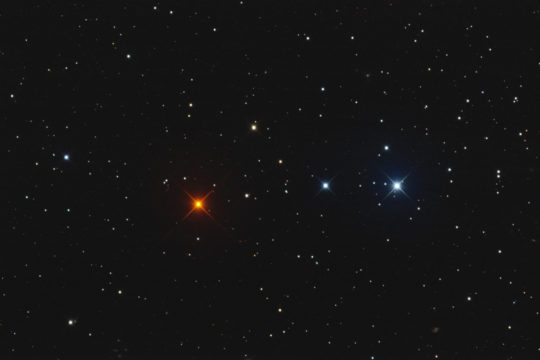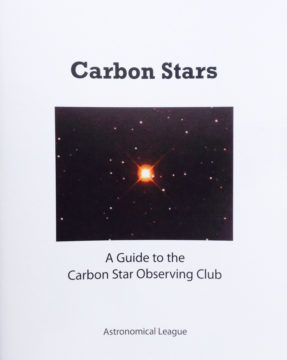Expand your spring and summer observing plans with a few of these red-orange carbon stars.
I always enjoy discovering a new star field that contains a carbon star. I admit I’m mostly in this for the aesthetics. Carbon stars range in hue from pumpkin orange to deep cinnabar red, and when surrounded by more common blue-white or yellow stars, carbon colors seem all the more remarkable. But the science of carbon stars is also interesting, as is the history of the classification system used to sort them, if only because it will help you recognize them in your atlases and databases.

Bob Franke
Carbon stars are mostly cool, evolved red giants. They’ve run through their hydrogen, collapsed toward their cores, and begun the process of fusing higher-order elements. As the fusion continues, core gases circulate upward, carrying the by-products of fusion — in this case, carbon and oxygen — to the stars’ outer layers. When circumstances are right, carbon and carbon compounds proliferate in the circumstellar shell material, forming a “soot” layer that gives a carbon star its particular red-orange color.
There are different ways to classify carbon stars, and you’ll probably encounter them all if you try to track down more than a few of these beauties. In older atlases, you might see the stars marked as N or R, designations that date back to Annie Jump Cannon’s spectroscopic work at Harvard Observatory. Cannon sorted stars that showed unusually strong carbon (C2) bands into group R and stars that showed strong cyanogen (CN) bands into group N. In 1928, C. Donald Shane, working out of Lick Observatory, further divided carbon stars into spectral classes R0–R9 and N0–N7, with N7 the reddest and R0 the bluest.
The R and N system is still in use, but now it’s more common to see carbon stars classified by their surface temperature. In 1941 Philip C. Keenan and William Wilson Morgan introduced such a system. The divisions ranged from C0–to C9, with C0 the hottest (about 4500K) and C9 the coolest (3000K). Yasumasa Yamashita (Tokyo Astronomical Observatory) further refined this scheme in 1975, adding a designation for the carbon band to the temperature class, for example, C7,3. The added number indicted the strength of the carbon band, with 1 being the weakest, 5 the strongest. You may also see a combination of these systems (C-R, C-N, C-J, C-H, C-Hd) in use, but the finer gradations of classification won’t affect your observing.
Carbon stars are often considered good targets for novice observers, but many of them are telescopic, rather than binocular, objects even at their brightest (most are long-period variables). Carbon stars appear redder when they’re at their minimum, but of course they’re also dimmer and may be beyond the limits of your equipment. If you can’t find a star, check its period and plot a current light curve and/or finder chart at the American Association of Variable Star Observers (AAVSO) website.
If a star has a period of more than 300 days, it can seem pointless to plan an observation for a year from now, when it’s at maximum. But even with such long-period variables, it doesn't take long for a star to be on the rise, so to speak. For example, when I once tried to pull then 10th-magnitude R Leporis (Hind’s Crimson Star) out of the light pollution from my suburban backyard, it was a no go. Not quite two months later, I picked up the red gem west of the rabbit’s ears with no problem. It was nowhere near maximum, but it was bright enough for me to see it.

To get started, try for VY Ursae Majoris. It’s circumpolar and high in the sky right now, so it can make for an uncomfortable observation for some telescope users. On the other hand, it stays relatively bright throughout its irregular period, ranging from magnitude 5.9 to 7.0, so it should be an easy target for binocular users. Another easy carbon star shines near the zenith this time of year — Y Canum Venaticorum. Commonly known as La Superba, Y CVn always looks ruddy to me, more red-orange than orange-red.
In the spring sky, give SS Virginis a shot. It’s easy to find, just 2º northeast of Eta (η) Virginis, and it’s notably orange-red. Even at its brightest (magnitude 6), it will seem dim compared to 4th-magnitude Eta, however. A little more challenging is 8.5-magnitude HD 113801, a rich C2 star about 10º south-southwest of Spica.
As Cygnus moves into the summer sky, take a look at RS Cygni, a star I first observed accidentally while searching for the elusive Basel 6 open cluster. RS Cyg forms the apex of a tiny isosceles triangle. It looked fairly yellow to me initially (comparable to the star on the triangle’s eastern point), but once I realized it was a carbon star, it miraculously began to seem more orange.
One of my favorite summer carbon stars is V Aquilae. This flame-colored variable star is easy to find, just off the line connect Lambda (λ) and 12 Aquilae. It’s one of the simplest star-hops you’ll encounter: Find Lambda, slide 1º south-southeast, and discover the marigold of V Aql.
I’ve compiled a list of more than 100 carbon stars to guide your observations. This lengthy list is available for download as a PDF or Excel file. I’ve listed the stars in order of right ascension (RA) and given the most common designations as well as Henry Draper (HD) numbers. It’s difficult to estimate the visual magnitudes of carbon stars; the ranges listed here should give you some idea of what’s possible.
Another good resource is the Astronomical League (AL) Carbon Star Observing Program. Currently coordinated by Robert “Rocky” Togni, the program includes 100 easy and difficult stars. You’ll find a blank space on each line of my list for (minimal) observing notes, but you may want to use the AL’s Carbon Star Log if you need space for further comments. If you find yourself wanting even more, pick up the AL’s carbon star observing manual (currently priced at $12 in the AL store).
Good luck, and I hope you see red!
 1
1









Comments
SNH
June 8, 2018 at 4:52 pm
Really appreciate the article, JR! Been collecting as many lists as I can of the brightest carbon stars lately to try for in my binoculars, so your list will be put to use! And your other links will be helpful as well as I dig deeper.
Thanks,
Scott
You must be logged in to post a comment.
You must be logged in to post a comment.